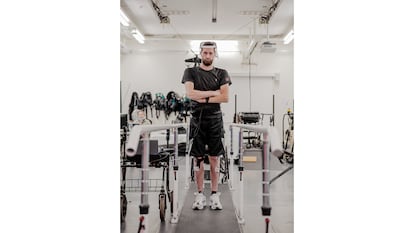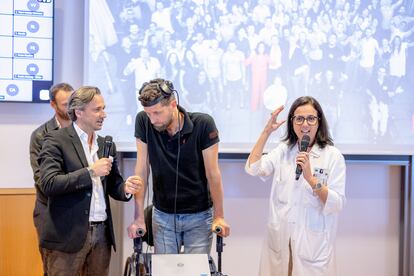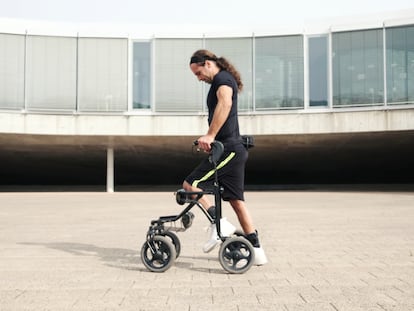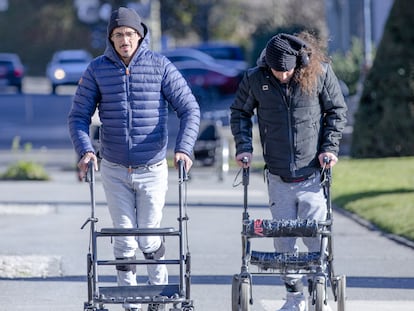A quadriplegic man walks again, thanks to a digital bridge between his brain and spinal cord
Dutch citizen Gert-Jan Oskam, 40, was left paralyzed after a bicycle accident. He can now climb stairs with the help of crutches
An international team of scientists announced on Wednesday “a new era” in the treatment of neurological diseases. Researchers have installed “a digital bridge” between the brain and spinal cord of Gert-Jan Oskam, a 40-year-old Dutch citizen who became quadriplegic after a bicycle accident in 2011 while returning home from work. Two implants in his brain can now read his thoughts and send them — wirelessly — to a third implant, which electrically stimulates his spinal cord. The patient is now able to walk long distances on crutches and even climb stairs with their help.
Oskam had previously tested out a more rudimentary device in another clinical trial. But this past Tuesday, he enthusiastically proclaimed the difference at a press conference: “Before, electrical stimulation controlled me. Now, I’m the one who controls the stimulation.”
Oskam’s bicycle accident caused an incomplete spinal cord injury, which allowed him to make some minor movements. Thanks to years of difficult rehabilitation, he managed to regain significant mobility in his arms. And, in 2014, another ray of hope arrived: a new scientific technique — involving electrical stimulation in the spinal cord by means of an implant — had been successful in rats in an experiment at the Swiss Federal Institute of Technology in Lausanne. The rodents — with their marrow cut in two — were capable of taking more than a thousand steps. In 2016, the strategy was also successful in monkeys.

Oskam was one of the first humans to test this experimental device in 2017. It emitted electrical pulses in his spinal cord, synchronizing them with his clumsy, voluntary movements. With a few buttons, the patient could manually control the stimulation of his legs. However, the new technology goes much further, according to Spanish neural engineer Eduardo Martín Moraud, who participated in the animal experiments. “This study is a big step towards the dream of restoring voluntary motor control in patients suffering from neurological diseases, such as spinal cord injuries, strokes, Parkinson’s and tremors,” he said.
Colombian neural engineer Andrea Gálvez, 32, is one of the main authors of the new study. “Gert-Jan already had an implant in his spinal cord, which allowed electrical stimulation and reactivated his leg muscles. In this clinical trial, we’ve placed two implants in the motor part of the brain — one in each hemisphere — which allows us to read the intention of movement, decode it and build a digital bridge, so that the stimulation in the legs is deliberate,” Gálvez explained. The study’s results have just been published in the journal Nature, the academic standard of the best science in the world.

The leaders of the investigation are the neuroscientist Grégoire Courtine and the neurosurgeon Jocelyne Bloch, from the Swiss Federal Institute of Technology in Lausanne. Their team has spent more than a decade perfecting the device, with the use of adaptive artificial intelligence. At the press conference announcing the results, Courtine acknowledged that “this technology is still in its infancy” and announced that the next step is to shrink the size of the devices and test them on more patients. So far, only Gert-Jan Oskam has tested them.
The system requires replacing about two square inches of skull with a titanium-containing material and carrying a small backpack with a processing unit. Bloch does not hide his enthusiasm about it: “To me, at first, this seemed like science fiction. And now, it’s a reality.” The company Onward — founded by Courtine and Bloch — is attempting to develop a commercial version of this digital bridge.
Neurologist Antonio Oliviero, from the National Hospital for Paraplegics, in Toledo, Spain, applauded the new work, but remained cautious. “It’s an important step, but at the moment, [Oskam] is the only patient. We don’t know to what extent [these results] can be normalized,” he stressed. Oliviero pointed out that Oskam demonstrates a small clinical improvement even when the system is turned off, which suggests that his neural circuits have reorganized themselves. “[Perhaps this technology] can be a rehabilitation tool,” he added.

Digital bridges are not the only promising alternative for people with spinal cord injuries. Oliviero mentioned the Puerta de Hierro public hospital in Madrid, which is testing a treatment with a patient’s own stem cells, injecting them into the exact place of his injury. Meanwhile, at the Rehabilitation Institute of Chicago, Chilean neuroscientist Mónica Pérez is experimenting with non-invasive electrical stimulation at multiple points in the brain, with encouraging results. And Antonio Oliviero’s own group is testing a drug that bolsters the excitability of motor neurons.
Martín Moraud — a 39-year-old neural engineer from Madrid who runs his own laboratory at the Lausanne University Hospital — believes that the level of precision achieved by his colleagues Courtine and Bloch is unprecedented. “It’s something that has been dreamed of for decades,” he said. Moraud is now trying to transfer the idea of a digital bridge to help patients suffering from Parkinson’s disease. “The concept is similar: having neural measures of motor intention — or of motor deficits — that can be used to stimulate the spinal cord,” he explained.
The Swiss institutions involved in this research have shared an emotional video of Gert-Jan Oskam, in which he is seen leaning on a counter with a beer and some fries, talking to two other people. “I’ve spent over 10 years without being able to stand up and have a beer with friends. These are things that people don’t normally value,” the patient says in the recording, with a smile.

Sign up for our weekly newsletter to get more English-language news coverage from EL PAÍS USA Edition
Tu suscripción se está usando en otro dispositivo
¿Quieres añadir otro usuario a tu suscripción?
Si continúas leyendo en este dispositivo, no se podrá leer en el otro.
FlechaTu suscripción se está usando en otro dispositivo y solo puedes acceder a EL PAÍS desde un dispositivo a la vez.
Si quieres compartir tu cuenta, cambia tu suscripción a la modalidad Premium, así podrás añadir otro usuario. Cada uno accederá con su propia cuenta de email, lo que os permitirá personalizar vuestra experiencia en EL PAÍS.
¿Tienes una suscripción de empresa? Accede aquí para contratar más cuentas.
En el caso de no saber quién está usando tu cuenta, te recomendamos cambiar tu contraseña aquí.
Si decides continuar compartiendo tu cuenta, este mensaje se mostrará en tu dispositivo y en el de la otra persona que está usando tu cuenta de forma indefinida, afectando a tu experiencia de lectura. Puedes consultar aquí los términos y condiciones de la suscripción digital.
More information
Archived In
Últimas noticias
David Bowie, the galactic thinker who encouraged us to break new ground
John Berger and the loss of rural culture
From police officer to bloodthirsty kidnapper: Terror in Mexico during the years of ‘The Ear Chopper’
Alain Aspect, Nobel laureate in physics: ‘Einstein was so smart that he would have had to recognize quantum entanglement’
Most viewed
- David King, chemist: ‘There are scientists studying how to cool the planet; nobody should stop these experiments from happening’
- Reinhard Genzel, Nobel laureate in physics: ‘One-minute videos will never give you the truth’
- Oona Chaplin: ‘I told James Cameron that I was living in a treehouse and starting a permaculture project with a friend’
- Mexico completes its trade shift with the entry into force of tariffs on China and countries without trade agreements
- Sinaloa Cartel war is taking its toll on Los Chapitos












































